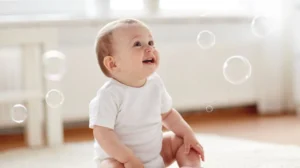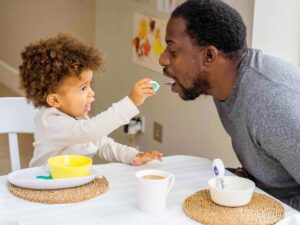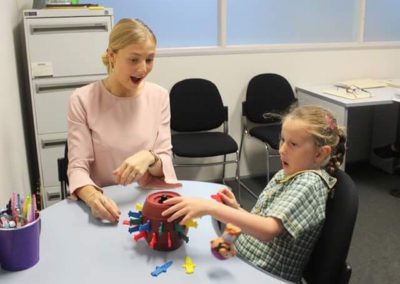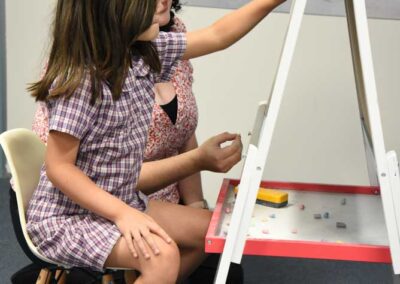Hearing your child’s first words is one of those magical parenting moments. But for many families, those first words don’t come as quickly as expected, and it’s natural to feel worried or unsure about what to do next. The good news is that you can support your child’s communication every day – without pressure, flashcards, or forcing them to “say the word.”
The best way to help your child talk is through responsive communication: noticing their interests, following their lead, and adding language in meaningful, fun ways.
Here are some easy, everyday strategies and examples to try at home.
1. Follow Their Lead

Instead of directing your child’s play, let them take charge. Watch what they’re interested in and talk about that. When children are engaged, they’re more likely to listen and eventually imitate words.
Example:
If your child is rolling a car, you might say:
- “Car go!”
- “Fast car!”
- “Crash!”
If they push the car to you, you can respond with “Go!” as you push it back. This turns it into a fun back-and-forth game that naturally encourages turn-taking and communication.
2. Comment, Don’t Question
It’s tempting to ask questions like “What’s that?” or “Can you say ‘dog’?” But this can feel like a test. Instead, try commenting on what your child is doing or looking at.
Example:
If your child points to the dog at the park, say:
- “Doggy!”
- “Big dog!”
- “Dog’s running!”
You’re showing them the words they might use later, without demanding a response.
3. Pause and Wait
After you say something, pause and look expectantly at your child. This gives them time to respond, even if it’s just with a sound, gesture, or look. Many children need several seconds to process language before responding.
Example:
If your child reaches for a snack, you could hold up the food and say, “Want banana?” Then pause, smile, and wait. If they make a sound or gesture, respond right away with, “Banana! Here you go.”
4. Add One More Word
If your child is using single words, model short two-word phrases. If they’re not yet using words, you can still expand on their gestures or sounds.
Examples:
- Child says “ball” – you say “big ball” or “throw ball.”
- Child points to the bubbles – you say “more bubbles” or “pop bubbles!”
- Child grunts or reaches – you say “help?” or “want up?”
Over time, these little expansions help build longer sentences.

5. Create Communication Temptations
Set up fun situations where your child wants to communicate. The goal isn’t to make them frustrated, but to encourage them to look to you or vocalise to get what they want.
Examples:
- Give your child a few blocks, then wait before giving more. When they look at you, say, “More blocks?” and hand them over.
- Blow bubbles, then stop and hold the wand. Wait for your child to gesture or vocalise before saying, “More bubbles!”
6. Use Daily Routines

Routine times like mealtimes, nappy changes, or bath time are full of natural chances to build language. Repetition helps your child understand and eventually say words.
Examples:
- During bath time: “Wash arms,” “Splash splash,” “All clean!”
- During meals: “More toast,” “Drink water,” “Yum!”
- Getting dressed: “Sock on,” “Zip up,” “Ready to go!”
When you repeat the same phrases each day, your child learns what they mean and may begin to copy them.
7. Celebrate All Communication
Every sound, gesture, or attempt counts. Smiles, clapping, or a simple “You said ‘ball’!” make children feel successful and motivate them to keep trying.
Avoid correcting their pronunciation – focus on encouragement. If they say “ba” for “ball,” you can model back naturally: “Yes, ball!”
8. Keep It Playful
Children learn best when they’re having fun. Singing songs, reading simple books, and playing games like peekaboo or hide-and-seek all support early communication skills.
Examples:
- Sing “Row, Row, Row Your Boat” and pause before the last word: “Row, row, row your…” (wait for them to fill in “boat!”).
- Read a favourite book and pause on familiar phrases: “The bear went over the…” (wait for “mountain!”).
These pauses give your child chances to take turns and join in.
Remember
Speech and language development happens at different rates for every child. The goal isn’t to make your child talk, but to connect with them through shared moments. When you tune in, respond, and add language in fun ways, you’re laying the foundation for communication that will grow over time.
If you’re ever concerned about your child’s speech and language development, you can contact us at Speak, Learn and Grow Speech Pathology Services on (02) 8522 7024 or fill in this form.









